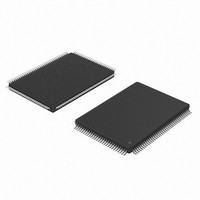AD9862BSTRL Analog Devices Inc, AD9862BSTRL Datasheet - Page 26

AD9862BSTRL
Manufacturer Part Number
AD9862BSTRL
Description
IC FRONT-END MIXED-SGNL 128-LQFP
Manufacturer
Analog Devices Inc
Datasheet
1.AD9860-EBZ.pdf
(32 pages)
Specifications of AD9862BSTRL
Rohs Status
RoHS non-compliant
Rf Type
LMDS, MMDS
Features
12-bit ADC(s), 14-bit DAC(s)
Package / Case
128-LQFP
AD9860/AD9862
For the Normal Operation mode, the Tx timing is based on
a clock derived from the DLL output, while the Rx clock is
unaffected by the DLL setting.
The Alternative Operation mode, timing utilizes the output of
the DLL to generate both Rx and Tx clocks. It also sets default
operation of the DLL to 4 mode.
Normal Operation is typically recommended because the Rx ADC
is more sensitive to the jitter and noise that the DLL may gener-
ate, so its performance may degrade. The Mode/TxBlank pin
logic level at power up or RESET defines in which mode the
device powers up. If Mode/TxBlank is low at power up, the
Normal Operation mode is configured. Otherwise, the Alternative
Operation mode is configured.
Rx Path (Normal Operation)
The ADC sampling rate, the Rx data output rate, and the rate of
CLKOUT1 (clock used to latch output data) are the parameters
of interest for the receive path data. These parameters in addition
to the data bandwidth are related to CLKIN by decimation filters,
divide by two circuits, data multiplexer logic and retiming latches.
The Rx path timing can be broken into two separate relation-
ships: the ADC sample rate relative to the input clock, CLKIN
and the output data rate relative to CLKOUT1.
The ADCs sample rate relative to CLKIN is controlled by the
ADC Div2 register and the sample rate can be equal to or one half
of the input clock rate.
The output data relative to CLKOUT1 has many configurations
providing a flexible interface. The different options are shown in
Figure 8. Table Ia and Ib describe the setup required to obtain
the desired data timing. RxSync is available when the Rx data is
decimated and multiplexed to identify which channel data is
present at the output bus.
CLKIN
A
ADC DIV2
0: B = A
1: B = A/2
ADC SAMPLE RATE
(NOT TO EXCEED 64MHz)
Tx DATA TIMING No. 1
Tx DATA TIMING No. 2
f
B
Tx
Figure 11. Dual Tx Timing Block Diagram, Alternative Operation
f
= 2 CLKOUT2
Tx
00: C = B
01: C = 2
10: C = 4
DLL MULT
= CLKOUT2
f
CLKOUT2
DLL OUTPUT RATE
(NOT TO EXCEED 128MHz)
B
B
C
Figure 12. Tx Timing Diagram
CLKOUT2 DIV
f
T
f
00: D = C
01: D = C/2
10: D = C/4
T
1
2
CLKOUT2
–26–
D
0: E = D
1: E = 2
2 EDGES
The Rx data (unless re-timed using the Rx Retime register) is
timed relative to the CLKOUT1 pin output. The Rx output data
can be decimated (halving the data rate) or both channels can be
multiplexed onto the channel A data bus (doubling the data rate).
Decimation enables oversampling while maintaining a slower
external data transfer rate and provides superior suppression of
out of band signals and noise. Multiplexing enables fewer digital
output bits to be used to transfer data from the Rx path to the
digital ASIC collecting the data.
When Mux Mode is enabled with an output data rate equal to
CLKOUT1 (Timing No. 3 in Figure 9) then the RxSync pin is
required to identify which channel’s output data is on the output
data bus. RxSync output is aligned with the output data, and by
default a logic low indicates data from Rx Channel B is currently
on the output data bus. If RxSync is logic high, then data from
Rx Channel A is currently on the output data bus. The Inv RxSync
register can be used to switch this notation.
The CLKOUT1 pin outputs a clock at the frequency of CLKIN or
CLKIN/2 depending on the voltage level applied to the CLKSEL
pin. If a logic low is applied to CLKSEL, CLKOUT1 will run
at half the CLKIN rate, if CLKSEL is set to logic high CLKOUT1
outputs a clock equal to CLKIN.
This timing flexibility along with the invert option for CLKOUT1,
controlled by the Inv 1 register allow for various methods of latch-
ing data from the Rx path to the digital ASIC, which will process
the data. These options are shown in Table Ia and Ib along with
a timing diagram in Figure 9. Not shown is the option to invert
CLKOUT1, controlled by the Inv 1 register. For this mode, relative
timing remains the same except the opposite edges of CLKOUT1
would be used.
D
INPUT
Tx DATA RATE
f
T
f
T
3
4
E
DUAL CHANNEL
FACTOR
F = E/2
INPUT Tx DATA RATE
EACH CHANNEL
F
00: G = F
01: G = 2
10: G = 4
INTERP
F
F
G
TxDAC UPDATE RATE
EACH CHANNEL
(CANNOT EXCEED
DLL OUTPUT RATE)
REV. 0












